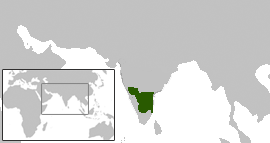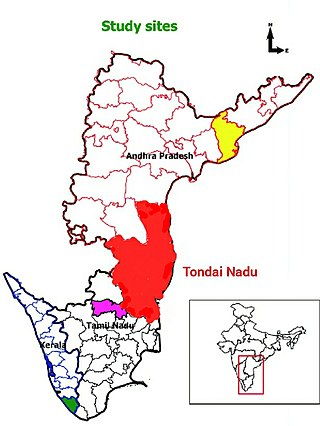Related Research Articles

The Pandyan dynasty, also referred to as the Pandyas of Madurai, was an ancient Tamil dynasty of South India, and among the four great kingdoms of Tamilakam, the other three being the Pallavas, the Cholas and the Cheras. Existing since at least the 4th to 3rd centuries BCE, the dynasty passed through two periods of imperial dominance, the 6th to 10th centuries CE, and under the 'Later Pandyas'. Under Jatavarman Sundara Pandyan I and Maravarman Kulasekara Pandyan I, the Pandyas ruled extensive territories including regions of present-day South India and northern Sri Lanka through vassal states subject to Madurai.

The Pallava dynasty existed from 275 CE to 897 CE, ruling a significant portion of the Deccan, also known as Tondaimandalam. The Pallavas played a crucial role in shaping in particular southern Indian history and heritage. The dynasty rose to prominence after the downfall of the Satavahana Empire, whom they had formerly served as feudatories.

Aditya Chola I the son of Vijayalaya Chola, was the Chola king who laid the foundation of the Chola Empire with the conquest of the Pallava Kingdom and the occupation of the Western Ganga Kingdom and Kongu Nadu. Aditya Chola I was succeeded by his eldest son Parantaka Chola I.

The Chola dynasty was a Tamil dynasty originating from southern India. At its height, it ruled over the Chola Empire, an expansive maritime empire. The earliest datable references to the Chola are from inscriptions dated to the 3rd century BCE during the reign of Ashoka of the Maurya empire. The Chola empire was at its peak and achieved imperialism under the Medieval Cholas in the mid-9th century CE. As one of the Three Crowned Kings of Tamilakam, along with the Chera and Pandya, the dynasty continued to govern over varying territories until the 13th century CE.

Vijayalaya Chola was a descendant of the Early Cholas, who revived the Chola dynasty and founded the Imperial Chola Empire. He ruled over the region to the north of the river Kaveri. He is one of the descendants of the famous Sangam age Chola king, Karikala Chola. According to the Anbil plates of Parantaka Chola II, his predecessor is Srikantha Choladhiraja, a Telugu Chola king who ruled the Renadu region, belongs to the Pottapi Chola lineage, and is a descendant of the ancient Tamil king, Karikala Chola. Vijayalaya was succeeded by his son Aditya Chola I who laid the foundation of the Imperial Chola Empire.
Vikramaditya I was the third son and followed his father, Pulakeshi II on to the Chalukya throne. He restored order in the fractured empire and made the Pallavas retreat from the capital Vatapi.
Kirtivarman II also known as Rahappa was the last ruler in the Badami Chalukya dynasty. He succeeded his father Vikramaditya II. His reign was continuously troubled by the growing power of the Rashtrakutas and Pandyas and finally succumbed to them.

The region of Tamil Nadu in the southeast of modern India, shows evidence of having had continuous human habitation from 15,000 BCE to 10,000 BCE. Throughout its history, spanning the early Upper Paleolithic age to modern times, this region has coexisted with various external cultures.
Kadungon was a Pandya king who revived the Pandya rule in South India in the 6th century CE. Along with the Pallava king Simhavishnu, he is credited with ending the Kalabhra rule, marking the beginning of a new era in the Tamil speaking region.
Arikesari Maravarman, also known as Parankusa, was a Pandya king of early medieval south India.
Kochchadaiyan, known as Ranadhira, (r. c. 700 – 730 AD) was a Pandya king of early medieval south India. He was the son and successor of Arikesari Maravarman. The name of the king is famously omitted in the Tamil portion of the Larger Sinnamanur Plates.
Varagunavarman II, also described as Varaguna II, was a king of the Pandya dynasty in south India whose reign lasted from c. 862 until c. 879 CE. Varaguna II was famously defeated by a contingent of troops led by Pallava king Aparajita around 879 CE.
Maravarman Rajasimha II was the last major king of the early medieval Pandya kingdom of south India. He was the son and successor of Parantaka Viranarayana. He is the donor of the Larger Sinnamanur Plates.
Maravarman Sundara Pandyan II was a Pandyan king, who ruled regions of South India between 1238–1240 CE.
Nandivarman III was an Indian monarch of the Nandivarman II line who ruled the Pallava kingdom from 846 to 869. He was the son of Dantivarman and the grandson of Nandivarman II.

Srimara Srivallabha was a Pandya king of early medieval south India.
Maravarman Avanisulamani was a Pandya ruler of early historic south India. He was the son and successor of Kadungon, who revived the Pandya dynastic power after the Kalabhra interregnum. Not much information is available about either of these kings.
Jayantavarman, known in Tamil as Seliyan Sendan, was a Pandya ruler of early historic south India. He is best known for extending the Pandya rule to the Chera country (Kerala). He was succeeded by his son Maravarman Arikesari Parankusan.

Tondaimandalam, also known as Tondai Nadu, is a historical region located in the northernmost part of Tamil Nadu and southernmost part of Andhra Pradesh. The region comprises the districts which formed a part of the legendary kingdom of Athondai Chakravarti. The boundaries of Tondaimandalam are ambiguous – between the river basins of Penna River and Ponnaiyar River. During the reign of Rajaraja I, this region was called as Jayankonda Cholamandalam.

The Velvikudi inscription is an 8th-century bilingual copper-plate grant from the Pandya kingdom of southern India. Inscribed in Tamil and Sanskrit languages, it records the renewal of a grant of the Velvikudi village to a brahmana by the Pandya king Nedunjadaiyan Varaguna-varman I alias Jatila Parantaka in c. 769-770 CE.
References
- ↑ Sastri, K. A. Nilakanta. (1958, second ed.) A History of South India from Prehistoric Times to the Fall of Vijayanagar. Madras, Oxford University Press. 165.
- ↑ Sastri, K. A. Nilakanta. (1958, second ed.) A History of South India from Prehistoric Times to the Fall of Vijayanagar. Madras, Oxford University Press. 165.
- 1 2 3 4 5 6 7 8 Sastri, K. A. Nilakanta. (1929) The Pandyan Kingdom. London, Luzac and Company. 56-58.
- 1 2 Sastri, K. A. Nilakanta. (1929) The Pandyan Kingdom.London, Luzac and Company. 51-52.
- ↑ Noburu Karashima (ed.), A Concise History of South India: Issues and Interpretations. New Delhi: Oxford University Press, 2014. 87-88.
- 1 2 3 Sastri, K. A. Nilakanta. (1958, second ed.) A History of South India from Prehistoric Times to the Fall of Vijayanagar. Madras, Oxford University Press. 149-50.
- 1 2 Noburu Karashima (ed.), A Concise History of South India: Issues and Interpretations. New Delhi: Oxford University Press, 2014. 88.
- 1 2 3 4 5 6 Sastri, K. A. Nilakanta. (1929) The Pandyan Kingdom.London, Luzac and Company. 57-58.